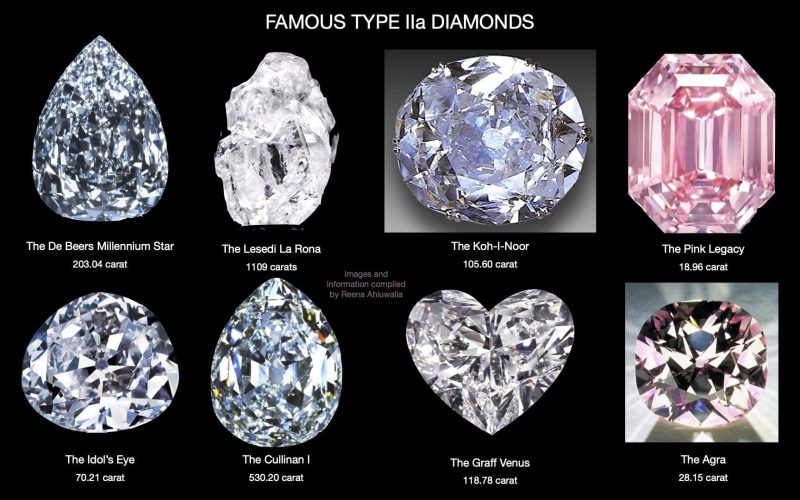The different types of diamonds are created equal. On the other hand, most individuals are more likely to evaluate the four C’s – cut, clarity, color, and carats – before classifying diamonds.
Is your diamond square or round? Is it squeaky clean, or does it include everything? What color is the diamond? These are diamond grading characteristics, not diamond types.
Furthermore, the Types of Diamonds categorization system divides stones into physical and chemical characteristics.
By examining its atomic makeup, gemologists can assess a diamond’s development, color, and, more significantly, whether it is natural, manufactured, or treated.
However, whether you’re doing a theoretical survey or studying gemology, this is probably not what you had in mind.
Furthermore, in this article, I’ll cover everything there is to know about diamond types. However, there are two ways to classify diamonds: the GIA’s and the consumer’s methods.
Let me begin with a consumer’s definition of the different types of diamonds.
1. Natural Diamond

You may come across the term “raw diamond” when studying different sorts of diamonds. Additionally, a raw diamond, described, has not been polished or cut.
(Note that this is the diamond in its natural state, not the gleaming stone you’re used to seeing on engagement rings.) Because it isn’t cut, it has a cloudier appearance than a standard white diamond due to its rough, jagged edges.
Although a raw diamond isn’t strictly flawless, it has become increasingly popular as the center stone for engagement rings.
Its rough, edgy finish appeals to individuals seeking a one-of-a-kind piece of jewelry. There isn’t much more to say about them. Essentially, most people imagine this when they hear the word “diamond.”
Before moving on to the following section, remember that one of the diamonds below is accurate, and the other is lab-grown. Are you able to distinguish which one is which?
2. Lab-Grown Diamond

Lab-grown diamonds are also one of the different types of diamonds. These diamonds have become a popular alternative to natural diamonds in recent years.
Thanks to advances in technology, diamonds can now be created in a laboratory rather than mined from the soil. A lab-grown diamond is a genuine diamond.
“The only difference between a lab-grown diamond and a mined diamond is its origin,” says Don O’Connell, CEO and President of Charles & Colvard. “Lab-grown diamonds, unlike those mined from the earth, are formed of carbon and are chemically, optically, and physically similar to mined diamonds.”
Additionally, Man-made diamonds can be produced in two ways. The first method, High Temperature, High Pressure (HTHP), employs presses to simulate the conditions in the earth’s crust.
After extreme heat and pressure exposure, a diamond seed grows into a fully formed diamond.
The second procedure uses Chemical Vapor Deposition (CVD) to produce a diamond from a hydrocarbon gas combination.
3. Natural Fancy Color
These are the most stunning gems (albeit I am biased:)). Colored diamonds are tough to come by.
When compared to everyday diamonds, the ratio is about 1 to 10,000. More and more celebrities have been seen wearing them in the last decade.
Whether as fashion statements on the red carpet or engagement rings – awareness (and demand) skyrocketed.
Furthermore, pink and canary yellow diamonds are the most well-known. Still, these stunning gems are available in every color of the rainbow, including blue, purple, violet, red, green, yellow, grey, white, and black, as well as combinations of these colors.
There are hundreds of brilliant colors—our comprehensive guide to diamond colors explains them in more detail.
These diamonds are also classified due to their rarity and high price. There are three types of colored diamonds: natural-colored diamonds, treated-colored diamonds, and lab-grown diamonds.
Meanwhile, black diamonds are the most well-known (or least well-known) examples. Black diamonds are incredibly uncommon.
4. Treated Diamond
Treated diamonds are also one of the different types of diamonds classified by consumers.
Diamonds were mined in the same way as conventional diamonds, but with their characteristics intentionally improved or modified to produce a better-looking diamond.
Two common treatments are inclusion filling, in which a particular material is used to “conceal” inclusions, and color enhancement.
Please keep in mind that these treatments are frequently applied to diamonds that cannot be sold otherwise.
Thus, the costs of these diamonds are significantly lower than the price of a comparable natural diamond that hasn’t been treated.
5. Type 1a Diamond
Type Ia diamonds are also one of the different types of diamonds by technical explanations. They have a yellowish tone, which is the first thing you’ll notice.
Why? Because nitrogen is found in aggregates (large clusters) throughout the crystal lattice.
Additionally, these aggregates absorb wavelengths of visible light on the blue end of the spectrum when nitrogen atoms are arranged in three groups.
As a result, the reflected light seems to be yellow. It’s worth noting that Ia diamonds are divided into two groups: IAA and IAB.
Furthermore, Diamonds with nitrogen aggregates in pairs are referred to as the former, whereas diamonds with four nitrogen atoms are referred to as the latter.
Neither form of light can be absorbed. Type I diamonds are also the most prevalent noted for their distinctive fluorescence and durability.
6. Type IIa Diamond
Type II diamonds have a variety of fluorescence, no apparent absorption, and no nitrogen impurities that could give a yellow or brown color.
These type IIa diamonds are also uneven and formed under extremely high pressure for lengthy periods.
Furthermore, Type IIa diamonds are the rarest and most precious of all diamond types, making them the most sought-after by collectors and investors.
Because this diamond makes up only 1% of all diamonds, it is costly and a better investment.
The fact that these stones have extremely little nitrogen, if any, within the crystal lattice means that they do not readily absorb short-wave light.
7. Type Ib Diamond
This kind is not as prevalent as type Ia, accounting for less than 1% of all-natural diamonds.
Rather than clusters, single nitrogen atoms are scattered across the crystal lattice in these stones.
According to the GIA, much visible light on the blue end of the spectrum is absorbed because it is scattered, resulting in an intense color—often yellow, orange, or brown.
Additionally, actual canary diamonds are a perfect illustration of this. This atomic formation can sometimes be found in yellowish-green diamonds.
8. Type IIb Diamond
Type IIb Diamonds are also classified by technical explanations. Like type IIa, they have no nitrogen atoms in their crystal structure.
These stones, however, differ from the others in that they contain boron. Furthermore, this element renders these diamonds electrically conductive and gives them a bluish or bluish-grey hue in most cases.
This is because boron absorbs light at the red end of the spectrum. Type IIb diamonds are likewise scarce, accounting for only 0.1 percent of all diamonds, making them incredibly precious. The blue tone can be a visual advantage for some.








